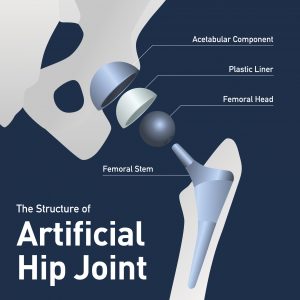Today I finish my conversation with Physical Therapist Amy Dougherty on specific problems that may arise with metal-on-metal artificial hip failures:
Clay: Over the past ten years you have seen a lot of metal-on-metal hip implants. Several years ago an attempt was made to put a metal-on-metal artificial hip together, and that was supposed to last forever, or last a whole lot longer, and it turned out that it was problematic. And I know you have had many patients who have had that [implant]. What did you see out of the metal-on-metal hip implants when they were failing?
 Amy: Again, the first cardinal sign that I saw was chronic pain, an inability to weight bear normally through that joint. So even after normal hip replacement, the patient should be able to weight bear through it. It should not feel like they collapse on that hip, and so a limp that never resolves or an inability to get away from an assistive device. So, I had a patient in her 50s that could not get off a walker. She was 50. She was playing tennis five days a week before she had her hip replaced. Yes, with the metal-on-metal she suffered metallosis and she had an overt failure of that joint replacement. She was a candidate for this new [metal-on-metal implant], now widely known to be a bad device, because she was so young, active, fit, and healthy. It was supposed to last for longer. It was supposed to allow her to have more function larger range of motion, less risk of dislocation and all of those things. So as we know, that did not really work out so well.
Amy: Again, the first cardinal sign that I saw was chronic pain, an inability to weight bear normally through that joint. So even after normal hip replacement, the patient should be able to weight bear through it. It should not feel like they collapse on that hip, and so a limp that never resolves or an inability to get away from an assistive device. So, I had a patient in her 50s that could not get off a walker. She was 50. She was playing tennis five days a week before she had her hip replaced. Yes, with the metal-on-metal she suffered metallosis and she had an overt failure of that joint replacement. She was a candidate for this new [metal-on-metal implant], now widely known to be a bad device, because she was so young, active, fit, and healthy. It was supposed to last for longer. It was supposed to allow her to have more function larger range of motion, less risk of dislocation and all of those things. So as we know, that did not really work out so well.
 In this week’s episode, Clay’s friend and former client shares her experience from recovering from not one, but three hip replacement surgeries. “Amy” discusses her journey from discovering her need for hip replacement surgery, to having the surgery, to how she knew the product was defective, and through her recovery process.
In this week’s episode, Clay’s friend and former client shares her experience from recovering from not one, but three hip replacement surgeries. “Amy” discusses her journey from discovering her need for hip replacement surgery, to having the surgery, to how she knew the product was defective, and through her recovery process. North Carolina Product Liability Lawyer Blog
North Carolina Product Liability Lawyer Blog








